The Basilica of the Sacré Coeur is the sacred heart of France, a true jewel in the crown of one of Paris’ most famous neighborhoods. Now it’s hard to imagine them separately – the majestic symbol of the conservative moral order of the Sacré Coeur and the creative, windy, somewhat rambunctious modern Montmartre. They complement each other, creating around them and combining an atmosphere of blessed tranquility and the charm of turbulent life.
The Sacré Coeur church in the French capital is considered one of the country’s iconic and most recognizable churches. In terms of popularity of visits this religious monument can be compared only with the Cathedral of Notre Dame of Paris. And despite the subjective opinion of Parisians that the Sacre-Coeur lacks the beauty and mystery of Notre-Dame-de-Paris or Saint-Chapelle, more than a million tourists annually seek to get to the famous Montmartre Hill to see this sacred place with their own eyes.
Montmartre and the Sacré Coeur – a tangle of stories
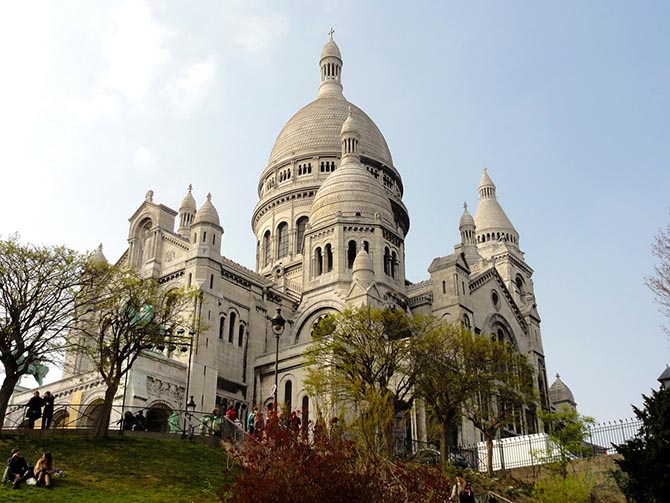
The Basilique du Sacré Coeur is located at the top of the hill of Montmartre, on the right bank of the Seine. In fact, the shrine is the last shrine in a long line of temples that have at various times stood on this famous and historically significant Parisian hill.
Contemporaries associate the Montmartre district of Paris exclusively with the creative bohemia, a drunken life, talented but poor artists. And yet the name “Montmartre” translates as “mountain of martyrs. At the time of the persecution of Christians by pagan authorities, bloody executions on top of the hill were common. According to legend, this is where they beheaded the first bishop of Paris, Saint Denis (Dionysius), who preached Christianity to the last drop of blood. And in the literal sense of the word. Legend has it that after his execution, Saint Denis took his head in his hands, his mouth continued to recite a prayer and so marched on until he was done. Only then did he drop dead. So if you see a sculpture of a man with his head in his hands, know – it’s St. Dionysius, the patron saint of French kings.
Sacré Coeur Basilica in Paris: the story of the symbol of divine love
The very name of the temple “Sacré-Cœur” means “Sacred Heart” or “Sacred Heart”. It is an important image for Catholics of the heart of Jesus Christ, which is the bottomless source of the Creator’s divine love for humanity.
The road to the Sacred Heart began in 1870, when the Franco-Prussian War and the Commune Revolution broke out. The Princes of the French Catholic Church decided that, after several years of violence and bloody riots, Paris needed a symbol of national repentance, a new shrine. It was decided to build a new place of worship on the Montmartre Hill. The project, approved by the National Assembly in 1873, was to build an imposing Christian church in Paris that would be visible from anywhere in the city. The very construction of the church had already become an appeal for unity and repentance – a nationwide fundraiser was announced.
The six architects of the Basilica of the Sacré Coeur
Seventy-eight architects took part in the competition to design the Temple of the Sacred Heart in Paris. But the design by an architect named Abadie won. As the “frontman” of the Sacre Couer, Paul Abadie unfortunately did not live to see the completion of the building and died in 1884. Since then, over the years, six different architects have worked on the temple, all of whom have contributed to the charm of the Parisian shrine. Very reminiscent of the story of Antoni Gaudi’s famous creation. After all, the great master also did not have time to finish his best work, the Temple of the Holy Family, or Sagrada Familia.
In its finished state, the Basilica of the Sacre Coeur opened only in 1914 – the year of the outbreak of the First World War. There is a sad irony in this, as the church was created as a symbol of national repentance for peace. Because of military events, the church was not consecrated until 1919.
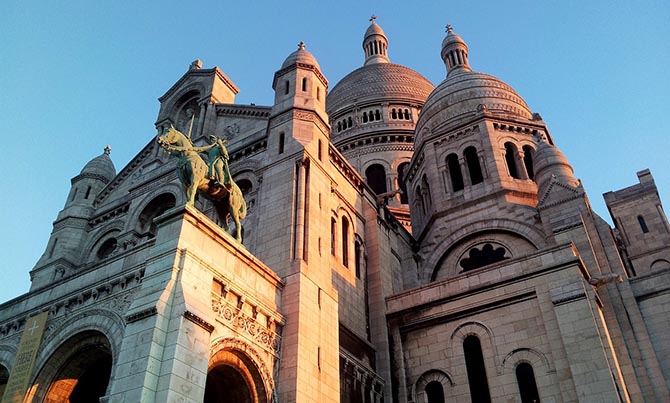
The architecture and interior of the Sacré Coeur
Inspired by the architecture of St. Mark’s Church in Venice, Paul Abadie chose a Romanesque-Byzantine style for the future basilica, which contrasted with the neo-Gothic fashion of that time in church construction.
The façade and interior of the Basilica of the Sacré Coeur in Paris are the refined splendor one expects from European architecture. An original material – travertine stone – was chosen to decorate the facade of the temple. This natural rock excretes calcite, which gives the walls of the shrine an unusually light color. The white stone against the blue sky is a stunning sight.
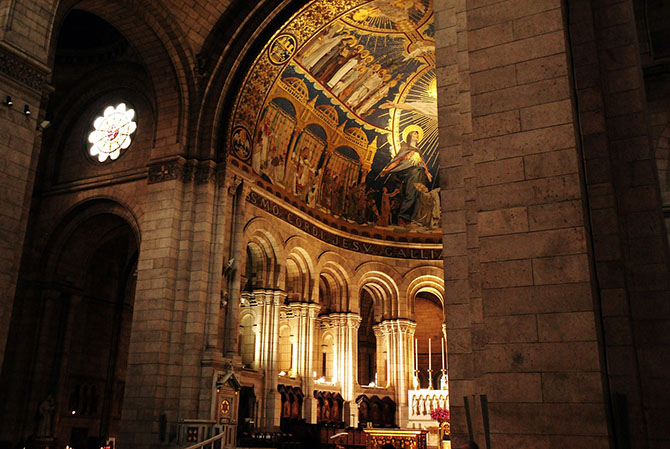
The muted interior of the Sacré Coeur contrasts sharply with its bright exterior. There is a minimum of architectural detail and a maximum of rich decoration – marble, gilding, smalt mosaics. The hand-painted frescoes of biblical scenes can be viewed for hours.
The star attraction of the Sacre-Coeur in Paris is undoubtedly its stained-glass windows and apsidal mosaics. The decoration covers an area of 475 square meters, glowing with rich shades of gold and blue.
Sacré Coeur dome and observation deck
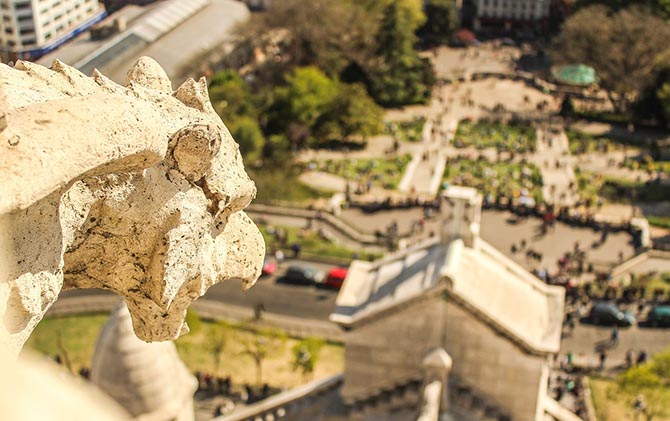
The white dome of the Basilica of the Sacred Heart has become an integral part of the Paris skyline. It is the highest observation deck in Paris with a stunning view of the city. True, to get to the dome you have to climb 237 steps without the help of an elevator (the stairs are on the left side of the cathedral). But it’s worth it! The photos of the city of love that tourists take from a bird’s-eye view are really magnificent.
In addition to the dome, panoramic views of the cityscape can be admired from the terraces next to the temple. On a clear day, the Eiffel Tower, Notre Dame de Paris Cathedral, Montparnasse Tower and many other Parisian landmarks can be seen perfectly from there.
The Crypt of the Sacré Coeur Church
Beneath the central altar of the basilica is a crypt that contains several burial halls – in which some church and historical figures of France are buried. Here you can see their tombs, monumental sculptures, as well as church art.
Interesting facts about the Sacré Coeur Cathedral in Paris
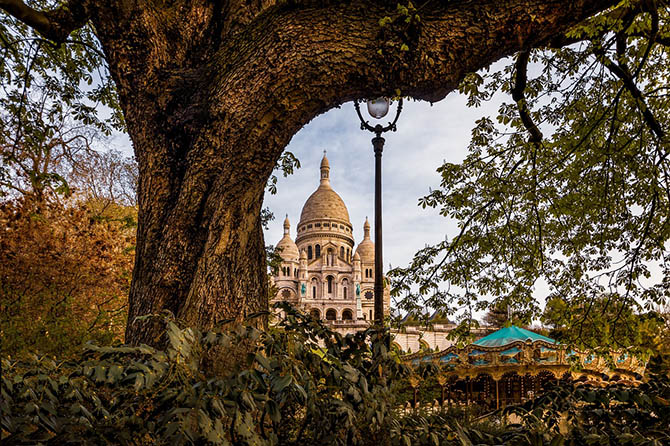
- Curiously, contemporaries for many years mercilessly criticized the Sacré Coeur. Not only was it considered completely alien to French culture. The very idea of this temple outraged many Parisians – they believed that its erection as a sign of penitence offended the memory of the Paris Commune and betrayed the ideals of the Great French Revolution. Among the critics of the basilica was, for example, the famous writer Emile Zola, who called the Sacré Coeur “an overpowering mass of stone, dominating the city where our Revolution began.
- On Sundays, the divine voices of little singers can be heard in the Sacré Coeur. Masses with the young angelic choristers of the basilica take place at 11 a.m., 6 p.m. and 10:15 p.m.
- The powerful Sacre-Coeur organ is one of the largest in the world. The instrument’s console consists of four manuals, keyboards for manual playing, and one pedal keyboard. For the Christmas holidays, on December 24, the temple hosts the only organ concert of the year.
- One of the bells of the Sacré Coeur cathedral, the Savoyard, weighs an impressive 19 tons and is the largest in Paris, one of the largest in France and the third largest in the world. It was cast in 1891 in the French Alpine town of Annecy. It is said that its ringing can be heard 40 km away!
How to get to Montmartre and the Sacré Coeur
The closest metro stations to the attractions:
- Anvers (line 2), then ascent by cable car or stairs;
- Abbesses (line 12), then take the cable car or the stairs;
- Jules Joffrin (line 12), then take the Montmartre bus to the Place du Tertre stop;
- Pigalle (line 12, 2), then by monmartrbus to the stop Norvins;
- Blanche, then walk.
You can also take buses 30, 31, 80 and 85 to the foot of the hill. But you still have to walk to Montmartre. And the hill, as you know, is at a height of 130 meters. If fitness allows, it is worth to do this way on foot, overcoming a lot of steps. A more comfortable option is to go up by cable car.
However, no matter what kind of transport you choose – it is almost impossible to get lost, the crowd of tourists itself will lead you in the right direction.
Working hours of the Basilica of the Sacré Coeur in Paris
Visiting time: The main entrance of the temple is open daily from 6.00 to 22.30.
After the closure of the Basilica, only those registered for the night Eucharistic adoration of the Holy Gifts can stay there.
Holy Masses are held daily, every four hours, beginning at 7:00 a.m. until 10:00 p.m.
Admission to the Sacre Coeur Church is free. There is a small line during the season, but it moves quickly.
But you have to pay to visit the crypt and climb the dome.
Check the official website of the Sacré Coeur for visiting information.
Montmartre audio guide
To make your walk around Montmartre and your visit to the Sacré Coeur basilica as interesting, informative and inspiring as possible, we have prepared a fascinating audio guide. It’s available on the Travelry mobile app. Download the app and download the audio tour “A Colorful Montmartre” in it, in which you will find many interesting
Tips for tourists in Montmartre
- The subway ticket is also valid on the funicular, which takes you to the top of Montmartre.
- Take care of your wallets and documents. People get robbed in Montmartre. This is no longer news. However, carelessness in popular tourist spots in Paris is not less.
- The best time for a tour of the hill Montmartre is dawn. It is beautiful and not crowded.
- When you go to Montmartre, bring a French baguette, cheese and some wine. A picnic on the grass in the Parc Louise-Michel with unparalleled views of the majestic Sacré Coeur and Paris would be a wonderful addition to the sightseeing program.
- If you don’t like to eat in the noisy tourist crowd, turn to the narrow unremarkable streets of Montmartre and look for cozy cafes and restaurants – they are cozier, and prices are more adequate than those near the main attractions.
- In Montmartre, there is a year-round tourist train. Excursion routes run along the popular places in the area: from Place Blanche (metro station Blanche, line 2) to Place Tertre and back. Tourists can get off at any location and then continue their journey.
